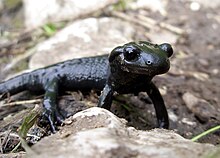Salamandroidea
| Salamandroidea Temporal range: fossil range:
157 mya – present | |
|---|---|

| |
| Salamandra atra | |
| Scientific classification | |
| Kingdom: | |
| Class: | |
| Order: | |
| Suborder: | Salamandroidea
|
| Families | |
Salamandroidea is a suborder of salamanders, the advanced salamanders. The members of the suborder are found worldwide except for Antarctica, Southern Sahara, and Oceania.
All members use internal fertilization.[1] The female is fertilized by a spermatophore, a sperm-containing cap put by the male in her cloaca. The sperm is stored in on the roof of the cloaca until it is needed at the time of egg laying.[2]
The earliest known salamandroid fossils are from the Tiaojishan Formation. They are dated to the late Jurassic period about 157 million years ago.[3]
References[change | change source]
- ↑ Miller, Jessica J. "Caudate families (newts & salamanders)". Livingunderworld.org. Archived from the original on 2007-10-16. Retrieved 2007-11-09.
- ↑ Sever, David M.; Stanley E. Trauth (1990). "Cloacal anatomy of female salamanders of the plethodontid subfamily Desmognathinae (Amphibia: Urodela)". Transactions of the American Microscopical Society. 109 (2): 193–204. doi:10.2307/3226814. JSTOR 3226814.
- ↑ Gao K.-Q. and Shubin, N.H. (2012). "Late Jurassic salamandroid from western Liaoning, China." Proceedings of the National Academy of Sciences (advance online publication). doi:10.1073/pnas.1009828109 [1] Archived 2019-09-15 at the Wayback Machine
